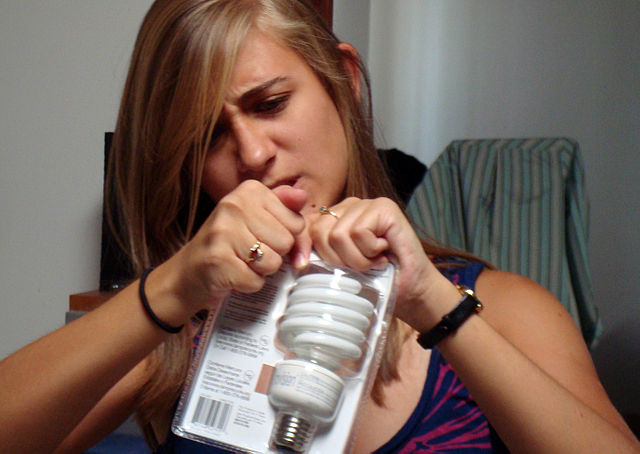There’s this funny comedy sketch from the old Carol Burnett Show, in which Carol’s character enters her kitchen with several bags of groceries. She’s hungry and she’s looking forward to snacking on some of the treats she just purchased. Unfortunately, she can’t  get any of the bags, boxes or cans opened! Over the next 5 minutes, she struggles in vain to get into various packages, and toward the end succeeds only in opening a gash in her thumb! She hurries to apply a band-aid, but … she can’t get into the protective sterile wrapper!
get any of the bags, boxes or cans opened! Over the next 5 minutes, she struggles in vain to get into various packages, and toward the end succeeds only in opening a gash in her thumb! She hurries to apply a band-aid, but … she can’t get into the protective sterile wrapper!
Have you ever experienced anything like this? We have. That is, one of us routinely struggles with opening kitchen items! Yes, one of us is container challenged! A bottle of cola? We need a pair of pliers to unscrew the top! A bag of chips: we need heavy-duty kitchen shears. And you know those wide-mouthed caps that come on those huge plastic bottles of laundry detergent — the caps that double as “wash load” measuring cups — we still haven’t quite figured out that one!
Once, we got this plastic tub of little frozen cream puffs, and we had to read the opening instructions three times before we figured out what the manufacturer was telling us. We located this nearly imperceptible indentation along the edge of the container, and (according to the label) needed to pry up near this indentation in order to “break loose” a tab. Once the tab broke loose, all we had to do was lift the lid at that corner. One big problem: we couldn’t get the plastic to break! We had to go to the garage and get a screwdriver, and then spent several aggravating moments digging and twisting into the edge of the plastic lid. Maybe the real “cream puffs” were outside the box!
 Sometimes we wonder if the engineers who design these cans, bottles, boxes and bags aren’t enjoying a private little joke at our expense. Then we remind ourselves that consumer goods are supposed to be hard to open — and there are good reasons why! Manufacturers want to protect their consumers, for one. They don’t want shoppers easily opening a can of mixed nuts in the aisle at Walmart to see if they’re salty enough to suit their tastes — or to simply satisfy a sudden snack attack — and then putting the container back on the shelf. Manufacturers want to protect their products from being consumed, contaminated, pilfered, and possibly even poisoned! (Yes, that actually happened a couple decades ago.)
Sometimes we wonder if the engineers who design these cans, bottles, boxes and bags aren’t enjoying a private little joke at our expense. Then we remind ourselves that consumer goods are supposed to be hard to open — and there are good reasons why! Manufacturers want to protect their consumers, for one. They don’t want shoppers easily opening a can of mixed nuts in the aisle at Walmart to see if they’re salty enough to suit their tastes — or to simply satisfy a sudden snack attack — and then putting the container back on the shelf. Manufacturers want to protect their products from being consumed, contaminated, pilfered, and possibly even poisoned! (Yes, that actually happened a couple decades ago.)
Furthermore, cleaning fluids and over-the-counter drugs labeled as “childproof” need to be just that: impervious to the curiosity and tenacity of industrious little kids! The downside of “safe and secure” packaging is that it makes it really tough for some of us to get into a bag of cookies or a box of crackers! We’re all for safety, but does everything have to be so hard to get into?!?!

Well, not everything in life is hard to get into. In fact, there’s at least two things we can think of that were actually designed to be easy to get into: the Family of God and, by extension, the Kingdom of Heaven. These two things aren’t even childproof! Jesus said, “…Unless you change and become like little children, you will never enter the Kingdom of Heaven.” (Matthew 18:3 Berean Study Bible)
The instructions for getting into God’s Family are easy to follow. It’s all outlined in the Word of God — and our Heavenly Father even made getting into His Word easy! The Gospel of Salvation through Christ is simple enough that even a child can understand it, because God wants everyone to have easy access to Him.

We may have trouble opening a can of spam, but opening our Bibles is a breeze! We may have trouble getting into a bag of chips, but getting into God’s Spiritual Family is a cinch: “But as many as received Him, to them He gave the right to become children of God, even to those who believe in His name….” (John 1:12 NASB)
Want God to open the way for you? Just follow these “EASY OPEN” instructions: “If you confess with your mouth that Jesus is Lord and believe in your heart that God raised him from the dead, you will be saved..” (Roman 10:9 NLT)

